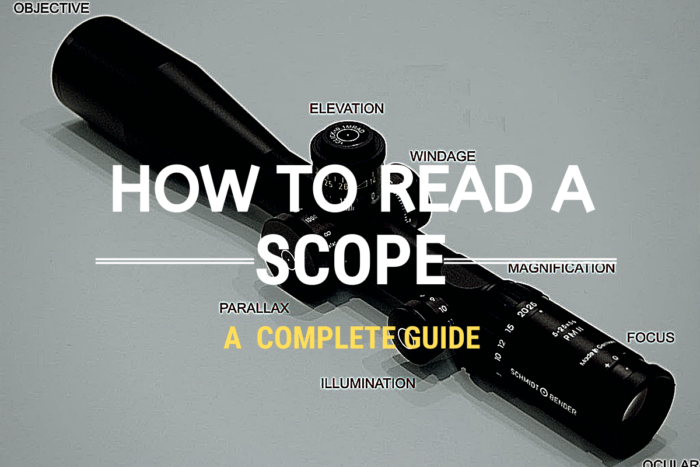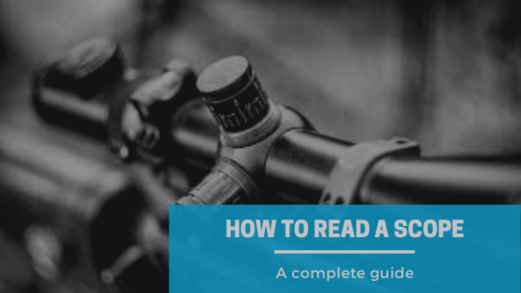Introduction
Unlike in the past when scopes were simple to read and understand even by first-timers, things have changed with the new generation scopes. The dots and calibrations were pretty basic and simple then. Also, users choosing a scope for their rifle or pistol had a limited choice of a red dot or simple crosshairs. And, that begs the question of “how to read a scope?” Today, there is a wide range of scopes out there. What is perplexing is that some scopes have new and advanced features that even some experienced shooters need the training to understand. They find it difficult to understand what the extra dots and lines mean.It may all seem complicated but once you have understood how it works you realize that it is not such a complex thing after all. Here is a complete guide.
How to read a scope number?
What the Numbers Mean? In most cases, you will see two numbers separated by an ‘x’. Each of these two numbers has a different meaning or represents a different reading.
The first number represents a magnification of the scope. Magnification means the number of times larger your target appears when you view it through the scope versus when you view it by the naked eye.
In some cases, a hyphen separates two magnification scope numbers before an ‘x’. Such scopes are known as Variable Scopes. For instance, they contain numbers such as 3-15x.
In this case, the first number represents a minimum magnification level while the second one represents the maximum magnification level. It means that you can adjust the magnification from 3 times larger the size to 15 times larger the size compared to your naked eye.
Whatever magnification you choose depends on the situation. For instance, if you are hunting a large game at a close range, a low power fixed scope with a 4x magnification is what will work best for you in such a situation. You can also use shotgun scopes for deer hunting.
You can check out the price of shotgun scope for deer hunting in here.
Such small magnification allows you to find your target more quickly besides offering you a wider field of view. However, for target shooting at longer ranges, you need a scope magnification of 16x to 20x.
The second number is the number that comes after the ‘x’ in the scope specs. This number represents the objective diameter of the lens of the scope. It is measured in millimeters. It is seen at the opposite of the side through which you are looking from.
The larger the objective lens the more light is allowed to pass through the scope. Hence, it makes the target to appear brighter and more visible. Scopes with larger objective lenses are typically helpful in low light situations such as at dusk or dawn.

Reticle Types and How to Read a scope reticle ?
There are various reticle types that every shooter should be aware of. Each type is unique at least in some way. Also, they have different features and may be read differently. Here are some of the most common reticle types, how to read them as well as a rifle scope terminology or two.
Basic Reticles
It features the most basic technology in reticles today. However, it is also the most popular and the easiest to understand among all the reticle types. It contains heavier lines that intersect at the center, with finer aiming lines. The larger lines allow you to find the center of the target more easily.
The fine lines at the center give you a precise aiming point while shooting. Once you have set your gun 2 inches high at 100 yards (rule of the thumb), use the ballistic rifle scope power chart and your approximation of the distance to your target to compensate for the bullet drop.
Bullet Drop Compensating Reticles
This type offers great accuracy when viewing longer distances. It helps you compensate for both windage and bullet drop. The bullet drop compensating reticle looks like a basic reticle but with dots or horizontal bars at increasing intervals downwards below the crosshair.
In some scopes, each of the bars or dots represents a 100-yard increment. As a shooter, you zero the gun at 100 yards, then you hold over your target on the correct dot or bar to compensate for distance. If you hold on to the third dot or bar at a range 300 yards, you should be able to shoot accurately.
You also need to understand how to maintain the highest level of accuracy. For this reticle to be accurate to its calibration, you are usually going to set the scope to its highest power. For instance, if you are shooting a 3-9x40mm rifle scope, you should set it at 9 power for the bullet drop to be on point and accurate.
In the case of second focal planes, when you look at the reticle and the image that you target as you increase the power from 3 to 9, the reticle will stay the same size but the image you are targeting will increase in size as you increase the magnification.
First Focal Plane Reticles
This is the third and the most complex among the three types of reticles. In this type of reticle, as you view the image being targeted, the reticle in 3 power is very small. However, as you increase the power, both the size of the reticle and the target image increase correspondingly. You also have to use the riflescope power chart for increased accuracy when using this reticle.
Final Verdict
With this guide, you should be able to understand not only the basics but also more regarding reading a scope. With proper guidance, even first-timers can find their way through making accurate shots if they are able to read the scope correctly. Whether you want to learn How to Read a Scope correctly to help you in shooting or you are just planning to use it for another purpose, this guide can still help you get through the process. Take your time, go through this guide and find your way through being a professional in reading scopes. Once you are used to it, you will realize that it is an easy thing.
